GeForce 471.96 Driver Performance Analysis – 23 games benchmarked, including Myst (2021) using an RTX 3080 and 2080 Ti
This driver performance analysis showcases the performance of a Gigabyte AORUS RTX 3080 MASTER (Ampere architecture) and an EVGA RTX 2080 Ti BLACK (Turing architecture) with 23 PC games including Myst (2021) using the latest GeForce 471.96 Game Ready driver. We compare these drivers versus our previously recommended driver 471.68 with both cards, and we perform all tests on the same game version and the same OS build.

Our testing platform is a recent install of Windows 10 64-bit Pro Edition, an i9-9900K with stock clocks, a Gigabyte Z390 AORUS PRO motherboard, and 32GB of Kingston DDR4 3333MHz. The games tested, settings and hardware are identical except for the GPUs we use and the drivers we compare.

Benching Methodology
Test Configuration – Hardware
- Intel Core i9-9900K (Hyper-Threading/Turbo boost on; stock settings)
- Gigabyte Z390 AORUS PRO motherboard (Intel Z390 chipset, v.F12l BIOS)
- Kingston HyperX Predator 32GB DDR4 (2×16GB, dual-channel at 3333 MHz CL16)
- Gigabyte AORUS GeForce RTX 3080 MASTER 10GB (rev. 1.0); v.F4 VBIOS, stock clocks
- EVGA GeForce RTX 2080 Ti BLACK EDITION GAMING 11GB, stock clocks
- Samsung 500GB SSD 960 EVO NVMe M.2
- WD Blue 1TB SATA SSD
- Corsair RM750x, 750W 80PLUS Gold power supply unit
- ASUS TUF Gaming VG289Q 28? IPS UltraHD (3840×2160) 60Hz 5ms FreeSync Monitor (Fixed Refresh Rate On) when testing games at 2160p resolution.
- ASUS ROG Swift PG279Q 27? IPS QuadHD (2560 x 1440) 165Hz 4ms G-Sync Monitor (Fixed Refresh Rate On) when testing games at 1440p resolution.
Test Configuration – Software
- NVIDIA GeForce 471.68 and 471.96 drivers; ‘High Quality’ and ‘prefer maximum performance’ (on a per-game profile-basis); fixed refresh rate (globally).
- Resizable BAR off – Why? Read main reasons here.
- V-Sync application controlled in the control panel, V-Sync off in-game.
- AA and AF as noted in games; all in-game settings are specified.
- Windows 10 64-bit Pro edition, latest updates v21H1, High-performance power plan, HAGS off (why?), Game Mode, Game DVR & Game Bar features off.
- GIGABYTE and ASUS tools not installed.
- Latest DirectX
- All 23 games are patched to their latest versions at the time of publication.
- 3DMark’s suite and UNIGINE Superposition benchmark, the latest version
- Basemark GPU benchmark, v.1.1
- UNIGINE Superposition, v.1.1
- CapFrameX (CX), the latest version
- RivaTuner Statistics Server (RTSS), the latest version
- Display Driver Uninstaller (DDU), the latest version; always uninstall old driver using DDU in safe mode, clean, and restart.
-
ISLC (Purge Standby List) before each benchmark.
GeForce Driver Suite-related
- We use Standard Game Ready drivers.
- The display driver is installed.
- We install the latest version of PhysX.
Hybrid & Non-Synthetic Tests-related
- Single run per test.
Game Benchmarks-related
- The corresponding built-in or custom benchmark sequence is used.
Frametimes Capture & Analysis tool-related
- CapFrameX is used for capturing and analyzing the relevant performance numbers obtained from each recorded built-in or custom benchmark sequence.
- Consecutive runs until detecting 3 valid runs (no outliers) that can be aggregated by CapFrameX using the following method:
- ‘Aggregate excluding outliers’:
- Outlier metric: Third, P0.2 (0.2% FPS percentile).
- Outlier percentage: 3% (the % the FPS of an entry can differ from the median of all entries before counting as an outlier).
- ‘Aggregate excluding outliers’:
- We compare and value the results and aggregated records in terms of percentages of gain/loss, by setting the following thresholds to consider a certain % value as significant (not within the margin of error) for our benchmarking purposes:
- Score/FPS Avg > 3% when valuing hybrid and non-synthetic benchmarks;
- FPS Avg > 3% when evaluating raw performance;
- P1/P0.2 > 3% when evaluating frame time consistency; after applying our custom formula
{[(LowPercentileFPS_2 / AvgFPS_2) / (LowPercentileFPS_1 / AvgFPS_1)] – 1} x 100
Benchmark Suite: 23 PC Games, 4 Hybrid & 4 Non-Synthetic Tests
Hybrid Tests (3DMark)
- Fire Strike Ultra
- Time Spy Extreme
- DirectX Raytracing feature test
- Port Royal
Non-Synthetic Tests
- Basemark GPU
- UNIGINE Superposition
- Neon Noir (Benchmark)
- Boundary: Raytracing Benchmark
DX11 Games
- Borderlands 3 (DX11)
- Chernobylite (DX11)
- Days Gone (DX11)
- Deus Ex: Mankind Divided (DX11)
- Far Cry New Dawn (DX11)
- Tom Clancy’s Ghost Ghost Recon Breakpoint (DX11)
- Neon Noir (DX11; Loop Mode)
DX12 Games
- Borderlands 3 (DX12)
- Cyberpunk 2077 (DX12)
- DIRT 5 (DX12)
- F1 2021 (DX12)
- Godfall (DX12)
- Horizon Zero Dawn (DX12)
- LEGO® Builder’s Journey (DX12)
- Metro Exodus (DX12)
- Metro Exodus PC Enhanced Edition (DX12)
- Myst (2021, DX12) – NEW
- Tom Clancy’s The Division 2 (DX12)
- Watch Dogs: Legion (DX12)
- Shadow of the Tomb Raider (DX12)
Vulkan Games
- DOOM Eternal (VK)
- Strange Brigade (VK)
- Quake 2 RTX (VK; v.1.5.0)
- Tom Clancy’s Ghost Recon Breakpoint (VK)
- Wolfenstein Youngblood (VK)
NVIDIA Control Panel settings
Here are the global NVIDIA Control Panel settings:
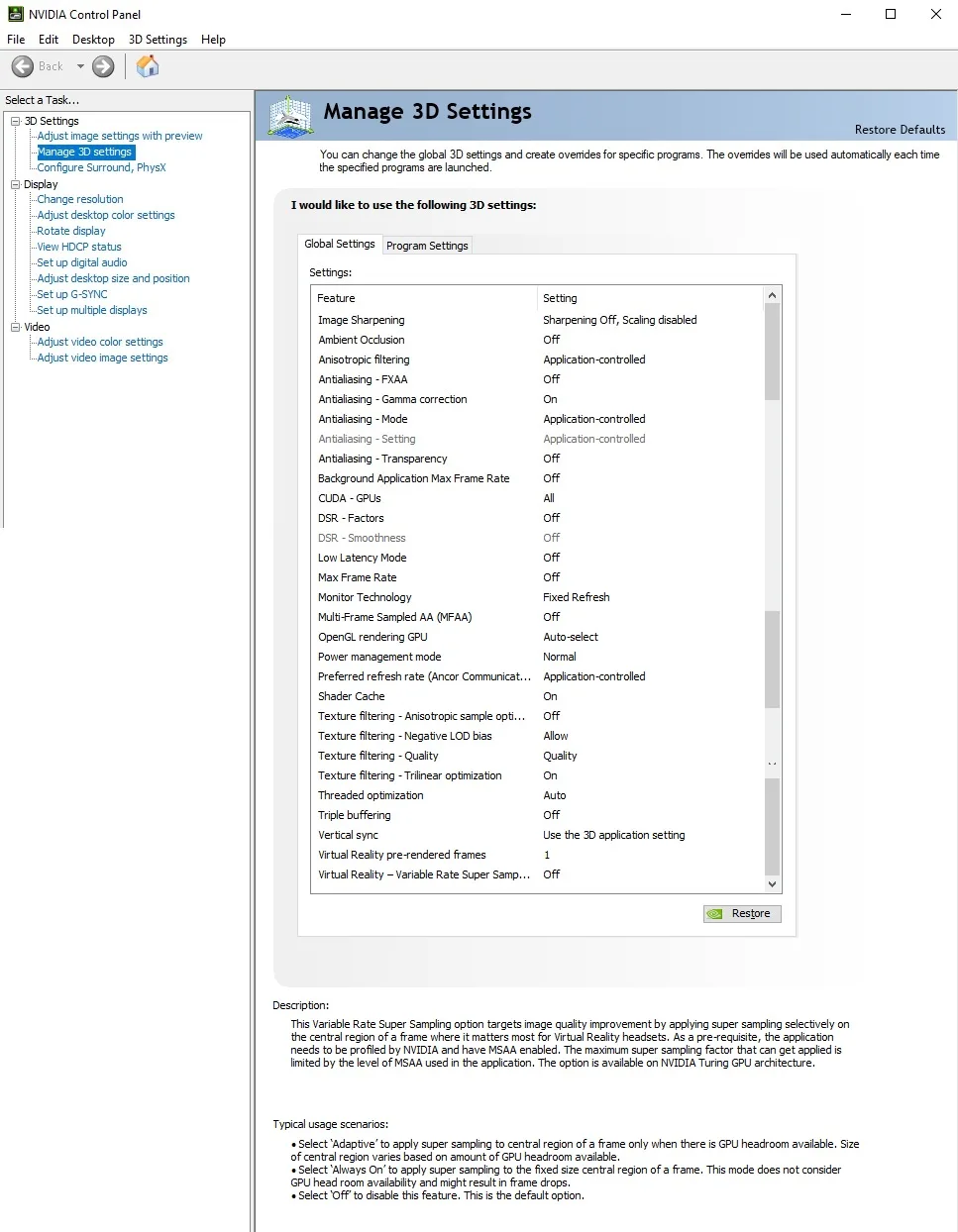
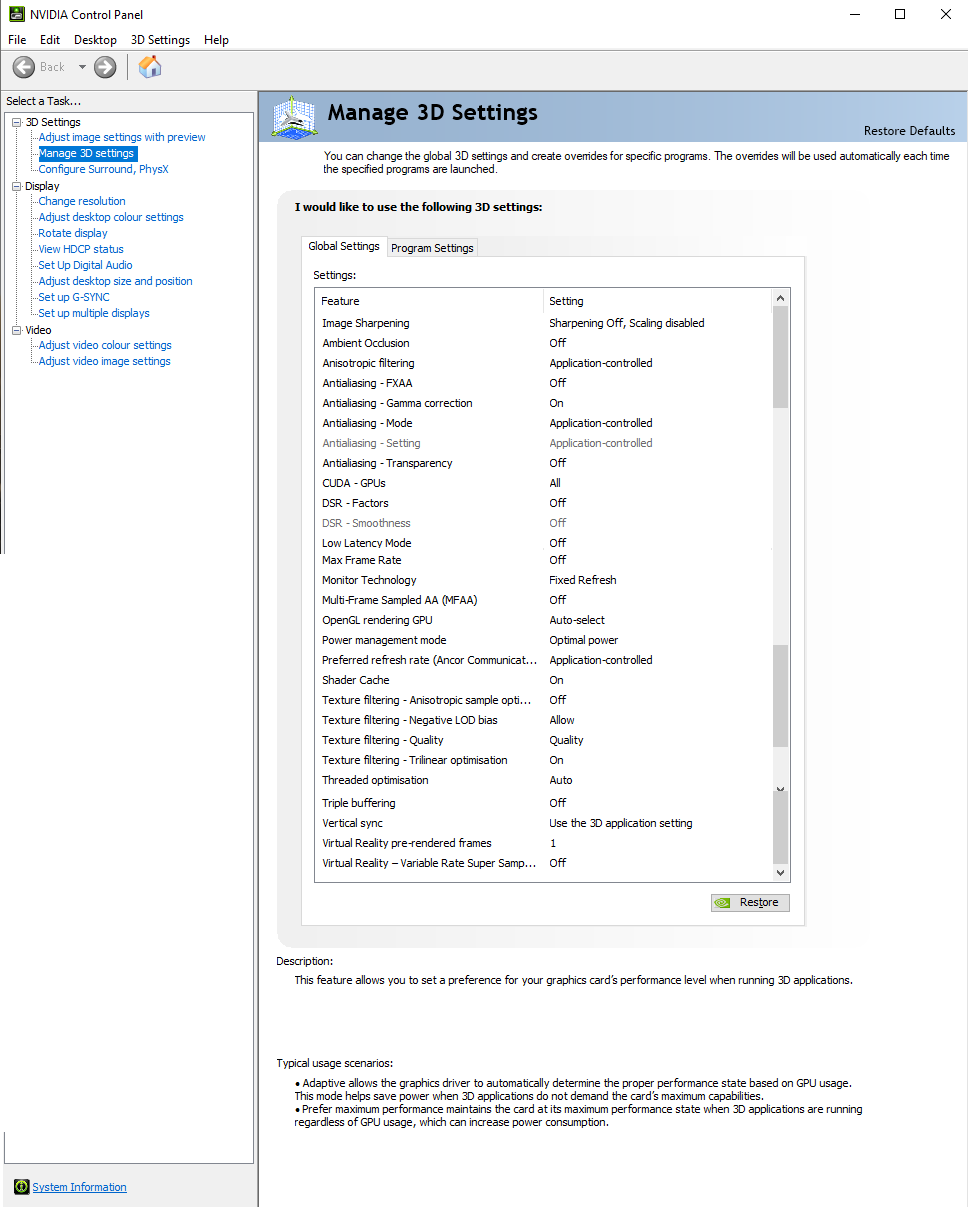
Both ‘High-Quality’ values for texture filtering-quality setting and ‘Prefer maximum performance’ for power management mode are set on a per-game or program profile-basis via Manage 3D Settings > Program settings tab.
GeForce 471.96 Game Ready WHQL Drivers
This latest GeForce Game Ready 471.96 driver was released on Tuesday (08/31/21) primarily to update scaling resolution for NVIDIA Image Sharpening.
This new driver adds support for 6 more monitors to the G-SYNC compatible list, bringing the total to 179 (EVE Spectrum ES07D03, Lenovo G27Q-20, MSI MAG321QR, Philips OLED806, ViewSonic XG250, and Xiaomi O77M8-MAS).
It also includes among others the following bug fixes:
- DPC latency is higher when color mode is set to 8-bit color compared to 10-bit color. [3316424]
- Unable to detect supported display modes for the Samsung Odyssey G9 display [3332327]
- Blue-screen crash/reboot loop occurs when two Samsung Odyssey G9 displays @ 240Hz are connected. [3256732]
- NVDisplay.Container.exe constantly writes data to C:\ProgramData\NVIDIA Corporation\nvtopps\nvtopps.db3. [3350171]
- [Windows 11][Notebook]: With the graphics mode set to Hybrid, the GPU frequently wakes up while idle. [3345922]
- [CUDA][Turing/Volta GPUs]: Stability issues with Topaz Denoise AI. [200755368]
The download links for the latest GeForce 471.96 drivers can be found starting here. The release notes can be found here as a downloadable pdf file. Here are the release highlights from NVIDIA’s website:
Game Ready Drivers provide the best possible gaming experience for all major new releases. Prior to a new title launching, our driver team is working up until the last minute to ensure every performance tweak and bug fix is included for the best gameplay on day-1. Additionally, this release also provides support for 6 new G-SYNC Compatible displays.

The Myst (2021) Performance Overview using an RTX 3080
Myst (2021), by Cyan Worlds Inc, is the latest remake of the iconic 1990s puzzle-adventure Myst game. Cyan reimagined the original Myst and rebuilt it to play in PC VR and flat-screen PC. Powered by Unreal Engine 4, it features updated and advanced graphics, real-time ray-traced reflections, and support for NVIDIA DLSS 2.0 technology to boost performance and deliver high-quality visuals.
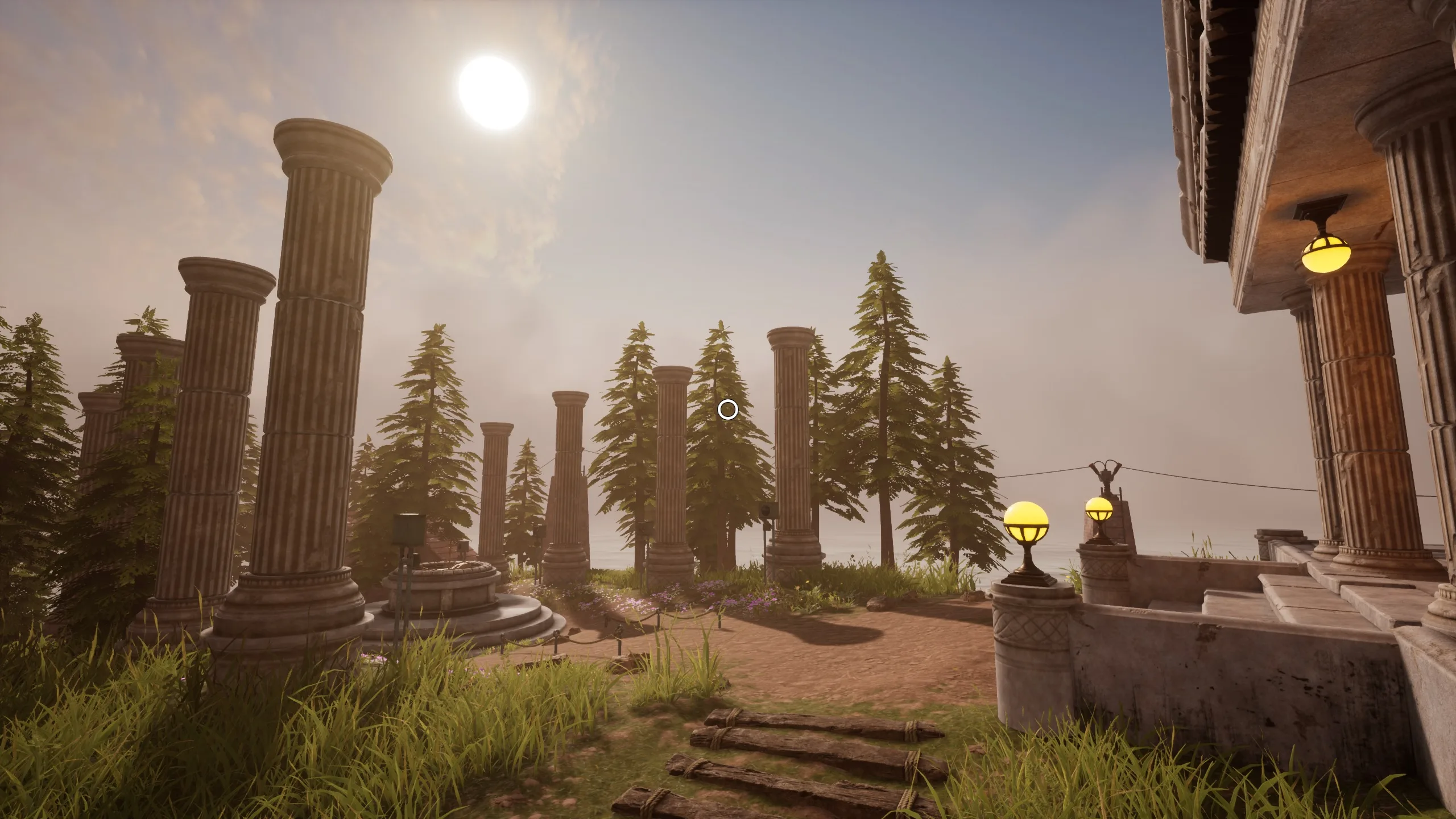
We use the latest 471.96 drivers to chart Myst’s performance using our RTX 3080 graphics card. We compare ray-tracing performance on versus off and also chart multiple DLSS settings/modes.
The Myst (2021) Summary Performance Charts
Ray Tracing On vs. Off

 Our performance results of Myst (2021) ray tracing on vs. off show an overall good optimization. We tested RT on and off without DLSS at 1440p resolution and Epic video quality settings and we saw an approximate 44% performance loss using RT on versus RT off.
Our performance results of Myst (2021) ray tracing on vs. off show an overall good optimization. We tested RT on and off without DLSS at 1440p resolution and Epic video quality settings and we saw an approximate 44% performance loss using RT on versus RT off.
Below you can see our frametime comparisons of Myst (2021) ray tracing on vs. off.
From the above chart, we see that Myst (2021) with ray tracing enabled and DLSS disabled shows an overall similar frametime stability to having ray tracing disabled. This is also confirmed using our custom stability formula which shows non-significant regressions on P1 and P0.2 metrics (approximately -0.5%).
However, if we look at the frametime variances and adaptive standard frametime deviations (adaptive STDEV FPS metric), we see that Myst (2021) with ray tracing disabled and DLSS disabled shows overall worse frame-pacing than with ray tracing enabled.
Ray Tracing & DLSS 2.0
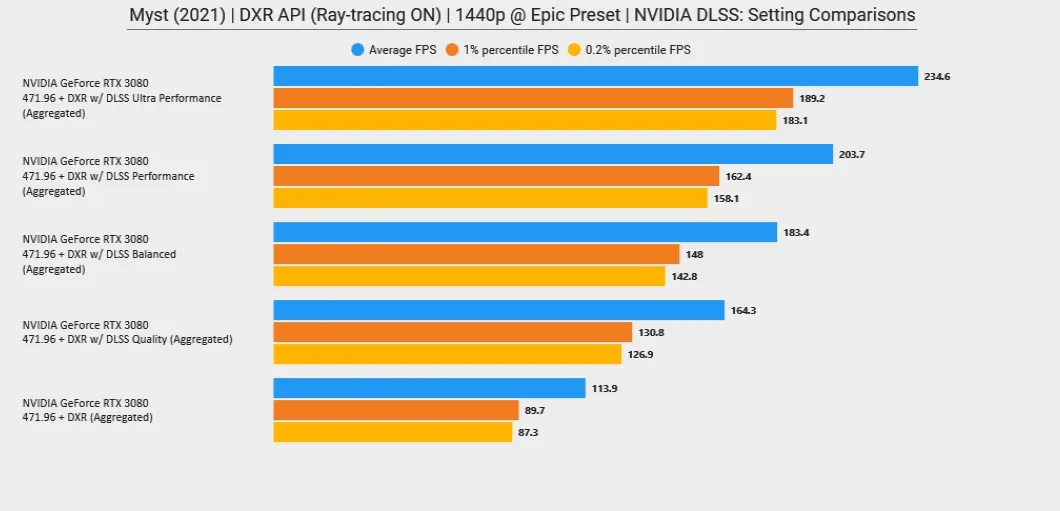
 Our results show a consistent and notable performance boost in ray-traced Myst (2021) due to the use of any DLSS 2.0 setting/mode. In fact, we see a performance increase of +44% going from DLSS off to DLSS Quality mode and up to +106% with DLSS Ultra Performance mode. We also see that Myst’s (2021) performance scales quite well when you move between the different DLSS settings.
Our results show a consistent and notable performance boost in ray-traced Myst (2021) due to the use of any DLSS 2.0 setting/mode. In fact, we see a performance increase of +44% going from DLSS off to DLSS Quality mode and up to +106% with DLSS Ultra Performance mode. We also see that Myst’s (2021) performance scales quite well when you move between the different DLSS settings.
If you want to play Myst (2021) with ray-traced reflections enabled, we highly recommend enabling DLSS Quality or Balanced mode to compensate for the notable ray tracing performance penalty while still getting good image quality.
The GeForce 471.96 Driver Performance – Summary Charts with 23 Games
Below you can find the summary charts of our representative selection of 23 games plus 4 hybrid and 4 non-synthetic benchmarks. We chart our games’ driver performance progression from version 471.68 to 471.96 using both the AORUS RTX 3080 MASTER and the EVGA RTX 2080 Ti BLACK.
You can see the list of graphics settings on the charts, and we run each built-in or custom game benchmark’s sequence at 2560×1440, except for Borderlands 3, Days Gone, and Far Cry New Dawn, tested at 3840×2160 resolution. You may click on each chart to open a pop-up for the best viewing.
Results give average framerates and higher is better. We display the low FPS percentiles (P1 and P0.2) below the corresponding averages. We use CapFrameX to record frametimes over time and to visualize and convert them into their corresponding average FPS and P1 and P0.2 FPS percentiles values.
There are also columns showing percentages of gain/loss in both raw performance (average FPS) and, when applicable, in frametimes consistency or stability between the different driver versions. We applied the following custom formula to calculate the stability gains or losses:
{[(LowPercentileFPS_2 / AvgFPS_2) / (LowPercentileFPS_1 / AvgFPS_1)] – 1} x 100
We mark significant performance changes (higher than 3%) in bold and use purple for the significant improvements or orange font for regressions.
GeForce 471.96 Driver Performance Charts



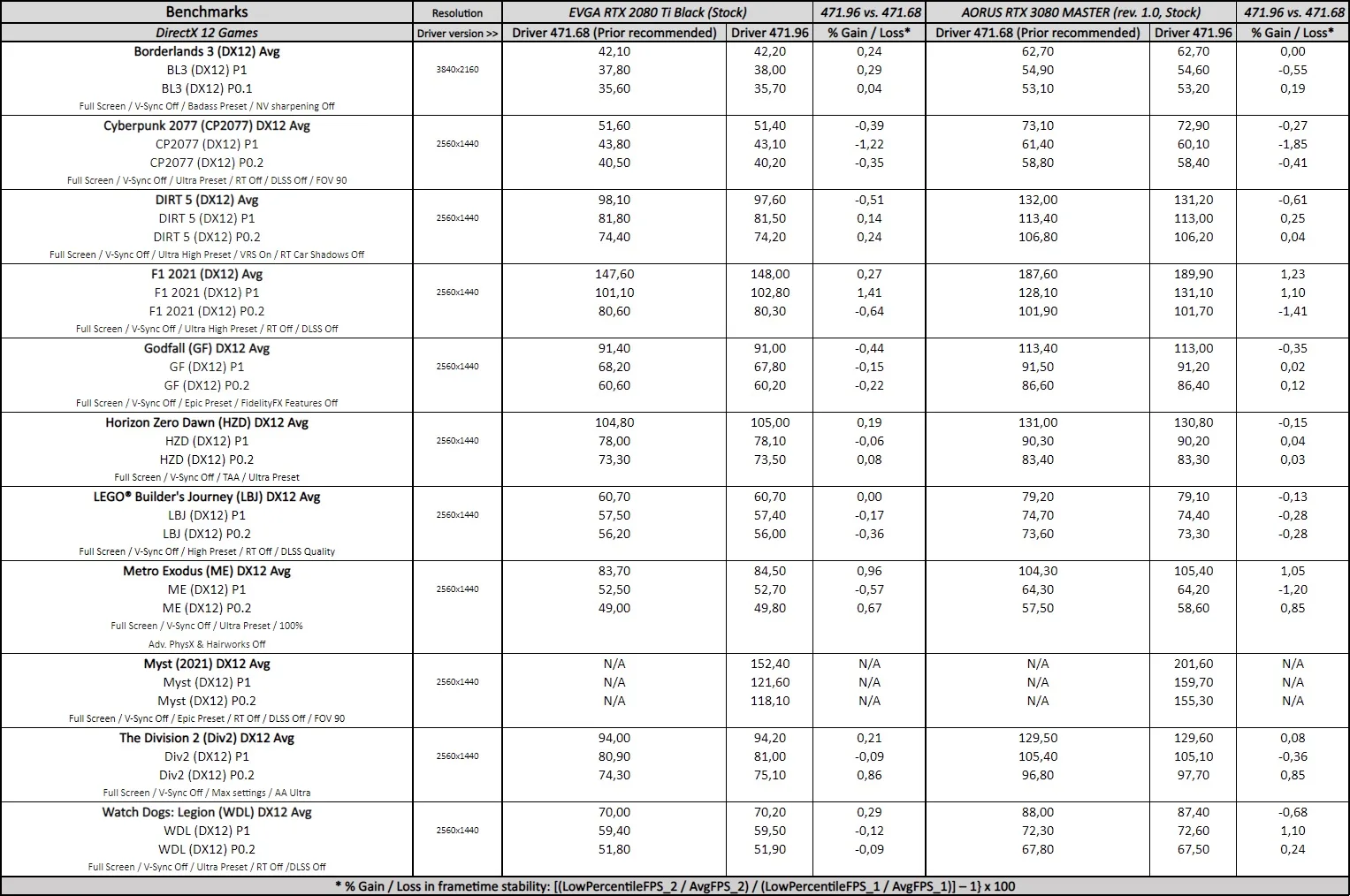



Notes on GeForce 471.96 Driver Performance
From the charts, we see no significant differences in graphics performance between drivers for both the hybrid and non-synthetic tests using both our RTX 3080 and RTX 2080 Ti.
Although most games show no significant differences when we move to 471.96 drivers from 471.68 using both GPUs, the game benchmarks show significant performance improvements in Borderlands 3 (DX11) in terms of raw performance, and with Chernobylite (DX11) and Metro Exodus PC Enhanced Edition (DXR) in terms of frametime consistency.
Disclaimer
Please be aware that the following results, notes, and the corresponding driver recommendation are valid for similar Ampere and Turing gaming rigs on Windows 10 v21H1. Its representativeness, applicability, and usefulness on different NVIDIA GPU architectures, testing benches, and MS Windows versions may vary.
Conclusion
Based on our previous results and findings, we recommend Ampere and Turing users to update to the latest GeForce 471.96 driver. Its raw performance and smoothness or frametimes consistency level are overall on par with our previously recommended driver 471.68 using both NVIDIA GPU architectures.
From a qualitative point of view, there are important reasons that also make it advisable to upgrade to version 471.96. These reasons include its higher level of driver bug fixes and support for the latest NVIDIA technologies.
Let’s Play!
***
Rodrigo González (aka ‘RodroG’) is an enthusiast gamer and tech reviewer especially interested in shooter games, open-world role-playing games, and software and hardware benchmarking. He is the author of the NVIDIA WHQL Driver Performance Benchmarks Series and founder and moderator of the r/allbenchmarks community on Reddit.
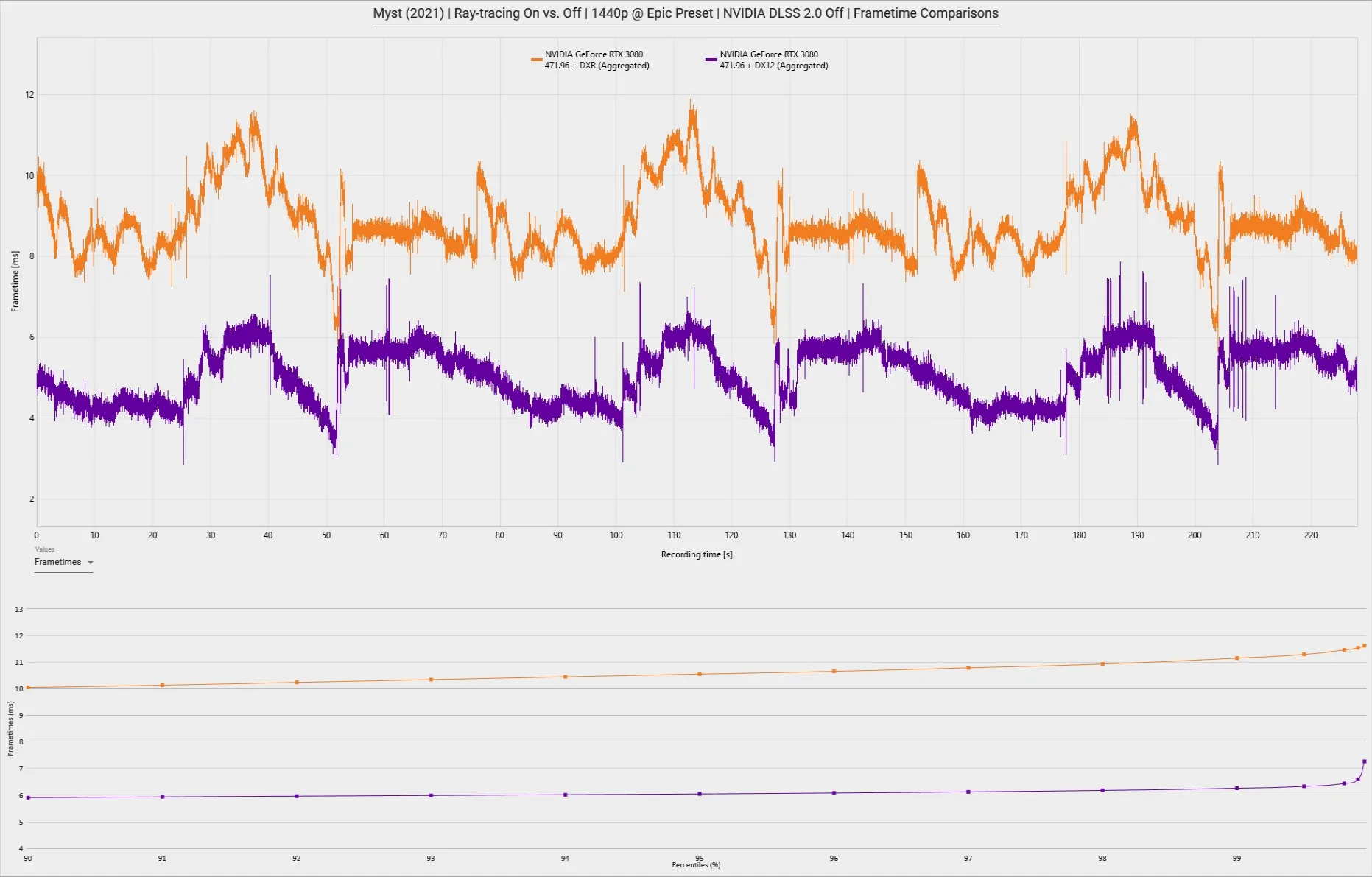
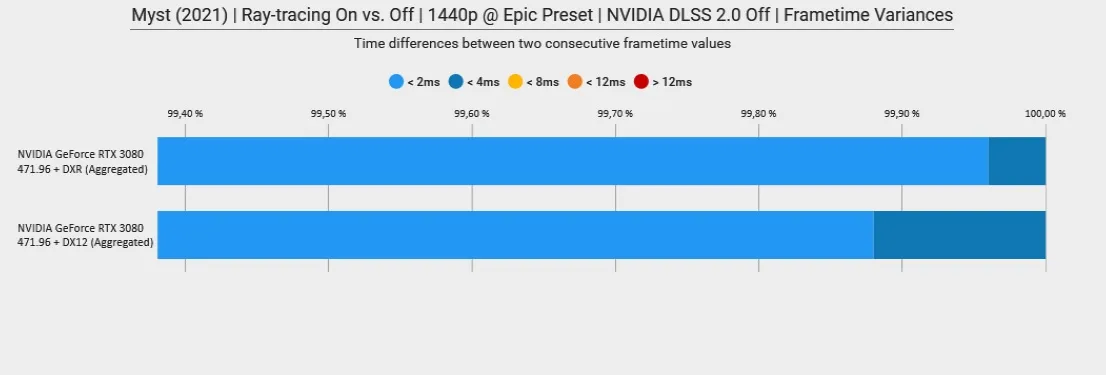

Comments are closed.